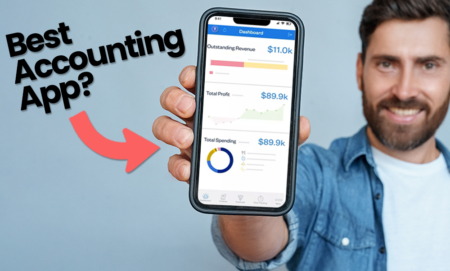As a freelancer, you’re often juggling many tasks —and bookkeeping tasks, like tracking expenses, sending invoices and providing receipts, are all an important part of keeping your freelance business afloat.
You gotta make money, right?
Business jargon can be intimidating, especially to someone who became a freelancer to use their creative skills. It’s easy to get confused between things that are similar, like invoices vs receipts. They both have to do with client billing and payments, but they serve a slightly different purpose.
Never fear! In this article, we’ll break down the differences between an invoice vs receipt. We’ll get into what each is for, and when you need to send them. We’ll even give you ideas on what those documents should look like.
Money Note: If an extra $1K–$5K/month would change your 2026 goals (debt, savings, travel, freedom), you’ll want to catch this: free live workshop from a freelancer who’s earned $4M+ online. No fluff. No gimmicks. A real roadmap. 👉 Watch the training or save your seat here »
Invoice vs receipt: how they are different
Let’s talk about an invoice vs receipt.
An invoice is a documentation of a transaction. It details work that you have done and how much your client has agreed to pay for it. The invoice represents a clear record that both parties can refer to in tracking earnings and expenses. (You can read more about the purpose of invoices here.)
A receipt, on the other hand, represents an exchange of money. It shows that a client has paid you a certain amount of money on a certain date. Not all clients will require a receipt, but some will.
In short, invoice vs receipt = request for payment vs proof of payment.
Invoices are sent before payment is received, receipts are sent afterwards.
The importance of both invoices and receipts
You can’t do business without some paperwork.
Sending invoices is the only way to get paid in most instances. It’s a signal that work has been completed and payment is owed. But getting paid isn’t the only reason you should use an invoicing system.
Invoices help track financial information for both parties. Invoices, vs receipts, can have as much detail as you need or want to include: dates, services offered, overage costs, etc. This way, if you need to refer back to income in the future, you’ve got all of the information available.
Invoices are also important for tax purposes. While you only need a running total for a simple tax form, if you are ever audited or if you have a dispute between a client’s report of your income and your own report, you are able to reference detailed invoices to figure out what happened.
If that’s not enough to convince you of the importance of invoices, consider all of the information they provide. If you track everything in a readable format, like a spreadsheet or using popular invoicing software, you can learn a lot about your own business.
What clients are most profitable? Who pays on time? Who doesn’t? Do your clients tend to come from a particular industry? Where are you spending hours that don’t pay off? Are there tasks with a big profit margin that you could outsource and free up more billable hours? All of this information can be used to grow your business in meaningful ways.
So what about invoices vs. receipts? Receipts are equally important to show that payment happened — both for you and your client.
Receipts are more than just a record of services rendered, they are proof that a payment happened. If you issue a formal receipt to clients after every exchange of money, no disputes can take place.
Receipts offer legal protection to both you and the companies or individuals you work with. If a client wants to dispute a payment, they can show proof that they already paid you the agreed upon amount. They also help your clients track their own expenses.
While paper receipts get the job done, there are more perks of digital receipts for the customer. For example, they’re more accessible and secure than the paper alternative.
How to create a proper invoice
So what’s the best method for creating an invoice?
There are essentially two ways of doing it: manually with a template, or using a software service.
For small companies or freelancers who only take on a few clients at a time, creating invoices manually might not be a big deal. You can use a program like Excel, Numbers or even Google Sheets to make a template that can be filled in with the appropriate information. These programs will do basic calculations for you, and they are inexpensive or even free to use.
If you take this route, just be sure to export them in a universal format, like a PDF, so your clients won’t have trouble reading the file. And keep meticulous records about what was sent where and when, so it’s easy to find the information you need.
Using software such as FreshBooks, Bonsai, or AND.CO can have a learning curve, and you will invest some money here, but if you are sending out more than a handful of invoices each month, it might be worth it in the long run.

You’ll pay a fee for these services, but they will help you look professional. Most services will send out invoices to clients right there in the program, and some will do automatic follow ups to collect payment. A good invoicing software will also track everything you need, making it easy to find information later on, tell the difference between an invoice vs receipt or even generate tax forms.
Don’t forget to include:
- Date the invoice was created
- Due date terms
- A description of the work completed
- The total amount
- Client information
- An invoice tracking number
- Sales tax, if applicable
- Other necessary information such as if the invoice has been partially paid, if there are late fees, discounts, etc.
You should agree what kind of invoice schedule you will be on with your client upfront. For larger projects, you may want to send invoices monthly, quarterly, or when large milestones are met. For smaller projects, it is customary to send the invoice when a project is complete.
What your receipts should include
When comparing an invoice vs receipt, a receipt is much simpler. The primary purpose of a receipt is simply to show proof of payment.
There is no legal definition of what a receipt is or what it must include. That said, you want the receipt to offer the legal protections mentioned above, so it makes sense to include a bit more than simply, “My client paid XX dollars.”
If you look at an invoice vs receipt, and take away most of the information, you’re basically left with what a receipt should look like. However, a receipt should include at least some detail. You need to list the service that was paid for, the date it was paid, and the method of payment. Don’t include credit card numbers or personal information, but saying whether it was a check, credit card, Venmo, PayPal, Stripe, or something else is helpful later on.
You should also provide either a handwritten or an electronic signature of some kind to validate the proof of payment. Even in this digital age, a signature carries legal weight.
If you want, a receipt can be as easy as taking an invoice, marking it “paid” in some fashion, and sending it to your client.
One of the best and easiest ways to create the perfect receipt is to simply ask your client what information is necessary for their purposes. That way there won’t be any back-and-forth or frustration.
If you’re using a bookkeeping software, receipts can generally be auto-generated just like an invoice. Just ensure you are sending the proper document at the proper time, so your clients aren’t confused by an invoice vs receipt.
Software solutions will generally send a receipt as soon as payment is received, so if you’re using a manual template instead, be sure to send the receipt in a timely manner. It is also helpful to clearly mark emails––when clients pay their invoices quickly, an invoice vs receipt might be difficult to identify.
Conclusion
If you have done any billing or expense tracking at all, you know that invoices and receipts both have their place in business. Familiarizing yourself with what each entails and how you can use them to your advantage is vital to expanding your freelance offerings.
If the invoice vs receipt question still seems frustrating, it’s probably in your best interest to get an easy-to-use accounting software that will do all of the heavy lifting for you.

The bottom line in billing is that you need to track everything. Paying attention to details like when you need to send an invoice vs receipt helps you structure your business in a smart way. Keep records of sales, records of payments, records of expenses, records of missed payments, and records of how long a project takes.
All of this information takes only minutes to input into a spreadsheet or bookkeeping software, and can prove invaluable on the backend.
There you have it, invoices vs receipts, demystified. Now you have one less thing to juggle––get back to business.
Keep the conversation going...
Over 10,000 of us are having daily conversations over in our free Facebook group and we'd love to see you there. Join us!


